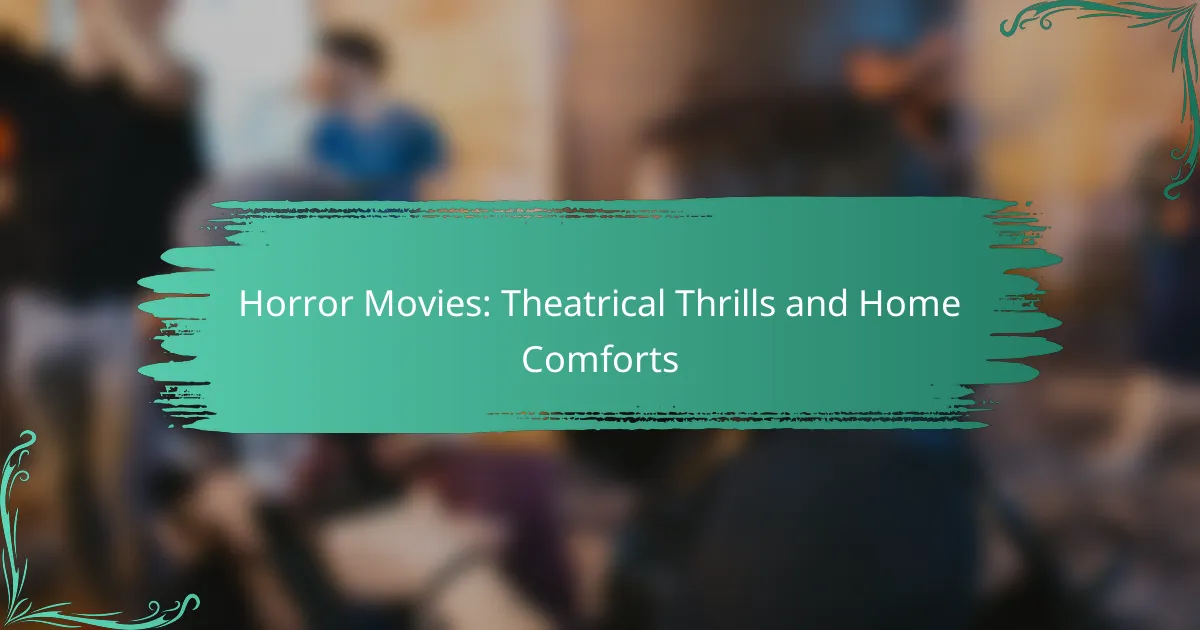Horror movies deliver unique thrills whether experienced in a theater or at home. The immersive atmosphere of a cinema enhances the suspense and fear through powerful visuals and sound, while home viewing allows for a more comfortable and flexible experience. Regardless of the setting, effective storytelling and relatable characters are essential for crafting a memorable fright.
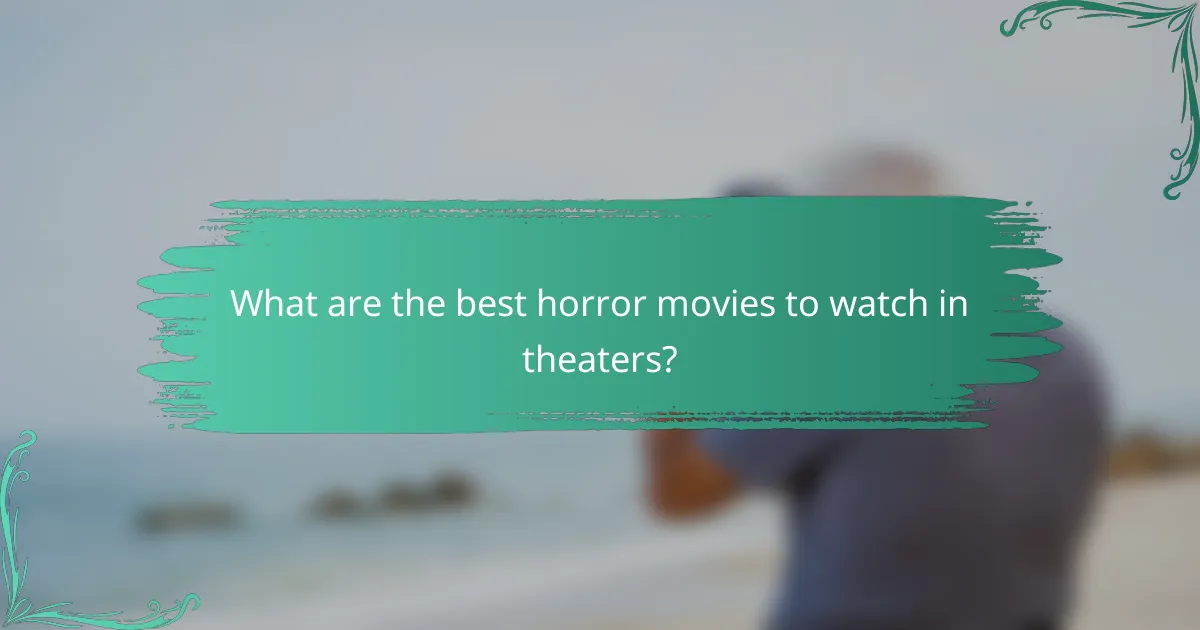
What are the best horror movies to watch in theaters?
The best horror movies to watch in theaters often combine thrilling narratives with high production values, creating an immersive experience. Films that generate buzz through trailers, reviews, and audience anticipation tend to be the most recommended for a theatrical viewing.
Top theatrical releases of 2023
In 2023, several horror films have captivated audiences, including “The Nun II,” which continues the chilling saga of the Conjuring universe, and “Talk to Me,” a fresh take on supernatural themes. These films have received positive reviews for their storytelling and suspenseful execution, making them must-sees in theaters.
Another notable release is “Evil Dead Rise,” which revives the classic franchise with a modern twist, appealing to both longtime fans and new viewers. Each of these films has leveraged effective marketing strategies, enhancing their visibility and box office performance.
Upcoming horror films to anticipate
Looking ahead, horror enthusiasts can expect exciting releases such as “The Exorcist: Believer,” which aims to revive the iconic franchise with a new storyline. Additionally, “Insidious: Fear the Dark” is set to expand on the popular Insidious series, promising more supernatural thrills.
These upcoming films are generating significant buzz, and early trailers suggest they will deliver the scares that fans crave. Keeping an eye on release dates and promotional events can enhance the anticipation for these titles.
Box office hits in the horror genre
Horror films have consistently performed well at the box office, with several recent hits grossing hundreds of millions worldwide. For instance, “It” and its sequel have set records, showcasing the genre’s ability to attract large audiences.
Successful horror films often feature relatable characters and innovative plots that resonate with viewers. Understanding trends in audience preferences can help predict which upcoming films might become the next box office sensations.
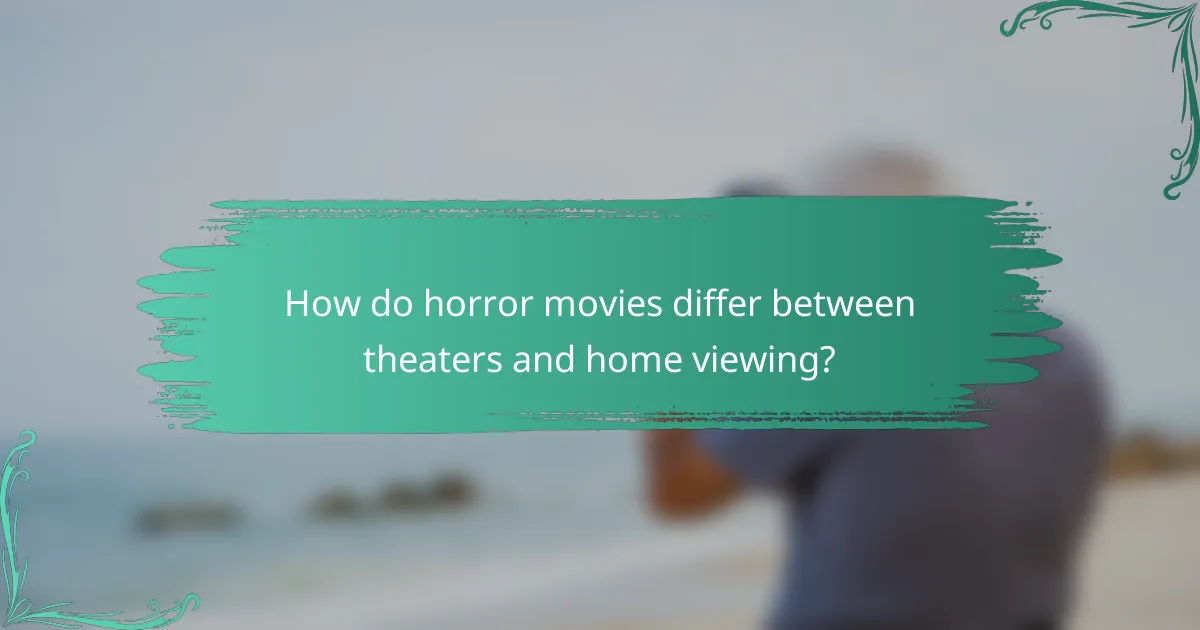
How do horror movies differ between theaters and home viewing?
Horror movies offer distinct experiences in theaters compared to home viewing. The theatrical environment amplifies suspense and fear through sound and visuals, while home viewing provides comfort and flexibility in how and when to watch.
Theatrical experience advantages
The theater experience enhances horror films through immersive sound systems and large screens that create a captivating atmosphere. The collective reactions of an audience can heighten tension, as shared gasps and laughter amplify emotional responses.
Additionally, theaters often feature specialized screenings, such as midnight showings or events with live commentary, which can add a unique twist to the viewing experience. The absence of distractions typically found at home allows viewers to focus solely on the film.
Home viewing comfort and convenience
Watching horror movies at home provides significant comfort and convenience, allowing viewers to create their ideal environment. You can adjust lighting, control volume, and take breaks without missing crucial moments, making it easier to manage intense scenes.
Home viewing also allows for flexibility in scheduling. You can watch a movie at your own pace, pause for snacks, or rewatch scenes that you find particularly thrilling. This can be especially beneficial for those who may feel overwhelmed by the intensity of horror films in a theater setting.
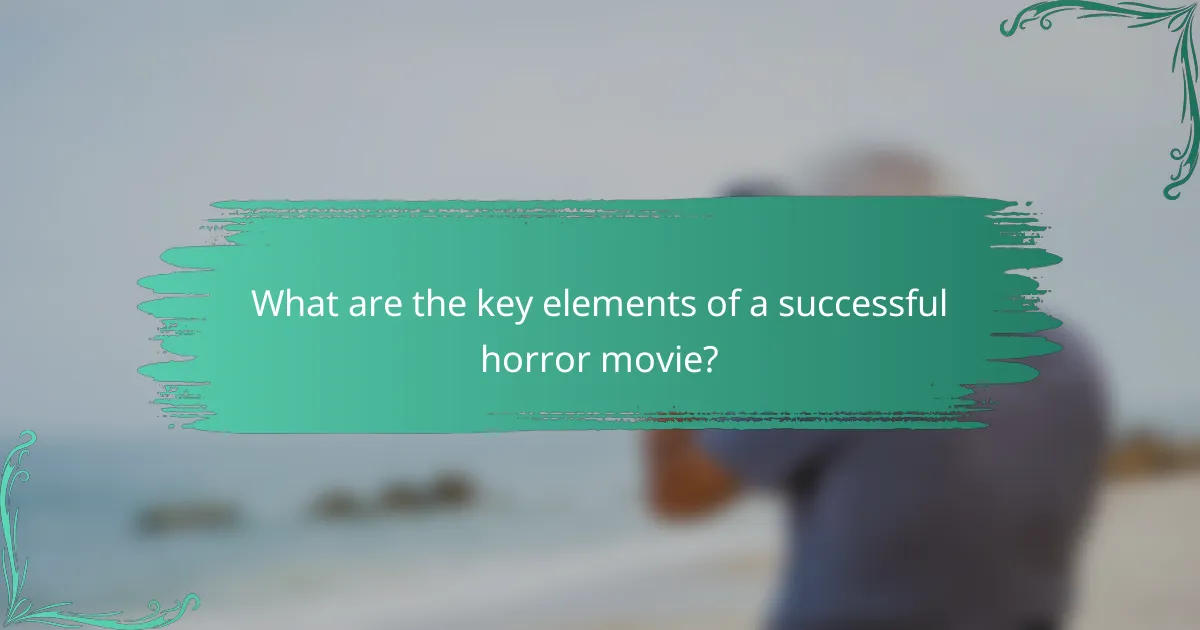
What are the key elements of a successful horror movie?
A successful horror movie typically combines effective suspense, relatable characters, and innovative storytelling techniques. These elements work together to create an engaging and frightening experience that resonates with audiences.
Effective use of suspense
Suspense is crucial in horror films, as it builds tension and keeps viewers on the edge of their seats. Techniques such as pacing, sound design, and strategic reveals can enhance suspense. For example, a slow build-up to a jump scare can amplify the shock when it finally occurs.
Filmmakers often use silence or minimal sound to create an unsettling atmosphere, making the audience anticipate what might happen next. A well-timed reveal or twist can also heighten suspense, keeping viewers guessing throughout the film.
Character development and relatability
Relatable characters are essential for audience investment in a horror movie. When viewers can connect with the characters’ fears and motivations, the stakes feel higher. Strong character arcs allow audiences to experience their struggles and triumphs, making the horror elements more impactful.
Common pitfalls include one-dimensional characters who serve only as plot devices. Instead, filmmakers should focus on developing characters with depth, allowing viewers to empathize with their situations. This connection can make the horror feel more personal and intense.
Innovative storytelling techniques
Innovative storytelling techniques can set a horror film apart from others in the genre. Non-linear narratives, unreliable narrators, and unique perspectives can create a fresh viewing experience. For example, telling the story from the antagonist’s point of view can provide a chilling insight into their motivations.
Additionally, blending genres or incorporating elements of dark humor can keep the audience engaged while still delivering scares. Filmmakers should experiment with different formats, such as found footage or anthology styles, to explore new ways to tell horror stories.
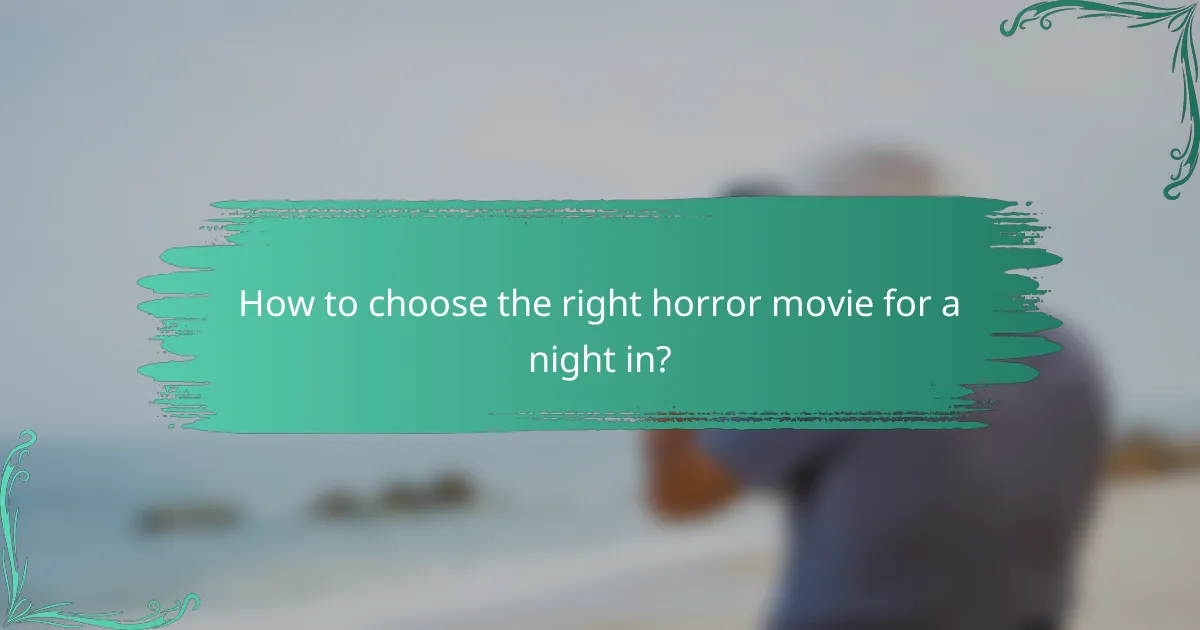
How to choose the right horror movie for a night in?
Choosing the right horror movie for a night in involves considering your audience’s preferences, the film’s age rating, and the mood you want to create. Start by assessing who will be watching and what type of horror resonates with them, whether it’s psychological thrillers or slasher films.
Audience preferences and age ratings
Understanding audience preferences is crucial when selecting a horror movie. Different age groups have varying tolerances for violence, gore, and psychological themes. For instance, films rated R may not be suitable for younger viewers, while teens might enjoy PG-13 horror films that offer suspense without excessive brutality.
Always check the age rating before making a selection. Familiarize yourself with common ratings: G (General), PG (Parental Guidance), PG-13 (Parents Strongly Cautioned), and R (Restricted). This will help ensure that the content aligns with the viewers’ comfort levels.
Genre subcategories to explore
The horror genre is diverse, encompassing various subcategories that cater to different tastes. Some popular subgenres include psychological horror, supernatural horror, slasher films, and found footage. Each offers a unique experience, from the mind-bending twists of psychological horror to the adrenaline rush of slasher flicks.
Consider exploring lesser-known subgenres like folk horror or body horror for a fresh perspective. These categories can provide a different flavor of fear, often rooted in cultural contexts or human experiences, making them intriguing options for seasoned horror fans.
Recommendations based on mood
Your mood can significantly influence the type of horror movie you choose. If you’re looking for something lighthearted, consider horror-comedies like “Shaun of the Dead” or “What We Do in the Shadows.” For a more intense experience, psychological thrillers such as “Hereditary” or “The Babadook” can deliver a gripping narrative.
If you want to create a suspenseful atmosphere, choose films with slow-building tension like “The Witch” or “It Follows.” Alternatively, if you’re in the mood for jump scares, classics like “The Conjuring” or “A Quiet Place” can provide the thrills you seek. Tailoring your selection to your current mood enhances the overall viewing experience.

What are the most popular horror movie franchises?
The most popular horror movie franchises include iconic series that have captivated audiences for decades, as well as modern hits that have redefined the genre. Franchises like “Halloween” and “The Conjuring” showcase a range of storytelling styles, themes, and cinematic techniques that keep viewers engaged and terrified.
Iconic franchises like Halloween
The “Halloween” franchise, which began in the late 1970s, is one of the most enduring horror series, known for its suspenseful storytelling and memorable characters, particularly Michael Myers. Over the years, it has spawned numerous sequels and reboots, each contributing to its legacy in unique ways.
Fans appreciate the franchise for its ability to blend traditional slasher elements with psychological horror. The original film set a standard for the genre, and its influence can be seen in many subsequent horror films. When exploring this franchise, consider watching the original alongside its latest installments to see how the themes and techniques have evolved.
Modern series like The Conjuring
The “Conjuring” series, which began in the early 2010s, has quickly become a cornerstone of modern horror, focusing on supernatural elements and based on real-life paranormal investigators Ed and Lorraine Warren. This franchise has expanded to include spin-offs like “Annabelle” and “The Nun,” creating a shared universe that enhances its appeal.
What sets “The Conjuring” apart is its emphasis on character development and emotional stakes, which resonate with audiences. When watching these films, pay attention to the connections between the main series and its spin-offs, as they often enrich the overall narrative. For a complete experience, consider viewing them in release order to appreciate the unfolding storylines.

What are the benefits of watching horror movies?
Watching horror movies offers unique benefits, including a thrilling psychological experience and opportunities for social interaction. These films can evoke strong emotions, providing both entertainment and a safe space to confront fears.
Psychological thrill and adrenaline rush
The psychological thrill of horror movies stems from their ability to elicit fear and suspense, which can trigger an adrenaline rush. This response can lead to heightened alertness and a sense of excitement, making the viewing experience exhilarating.
Many viewers enjoy the cathartic release that comes from confronting fear in a controlled environment. The adrenaline produced can also enhance mood and create a sense of accomplishment once the film concludes.
Social bonding experiences
Horror movies often serve as a catalyst for social bonding, as friends and family gather to share the experience. Watching together can lead to shared reactions, laughter, and discussions about the film’s themes, enhancing connections among viewers.
Organizing horror movie nights can be a fun way to strengthen relationships. Consider creating a themed event with snacks and decorations to elevate the experience, making it memorable and enjoyable for everyone involved.
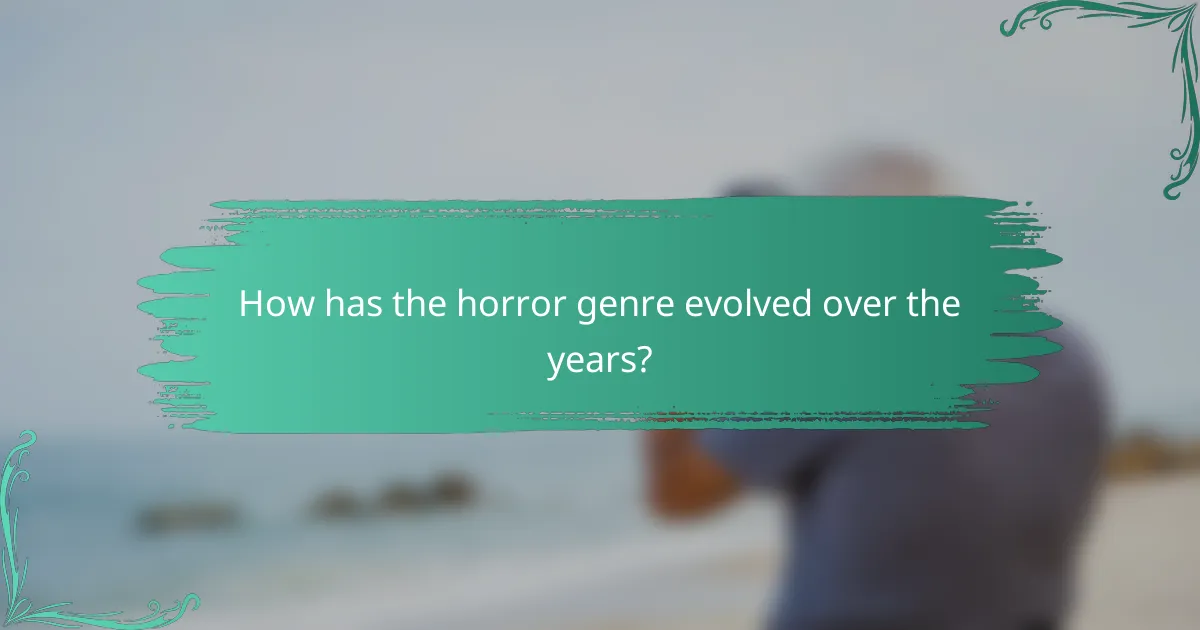
How has the horror genre evolved over the years?
The horror genre has transformed significantly, reflecting societal fears and technological advancements. From the early silent films to today’s high-tech thrillers, horror has adapted to engage audiences in new and innovative ways.
Classic horror vs. modern interpretations
Classic horror films, such as “Nosferatu” and “Psycho,” relied heavily on atmosphere, suspense, and psychological tension. These films often used limited special effects, focusing instead on storytelling and character development to evoke fear.
In contrast, modern interpretations of horror frequently incorporate advanced visual effects, sound design, and diverse storytelling techniques. Films like “Get Out” and “Hereditary” blend traditional horror elements with social commentary, appealing to contemporary audiences’ desire for deeper narratives.
While classic horror often emphasized the unknown and supernatural, modern films may explore psychological horror, technology, and societal issues, creating a broader spectrum of fear. This evolution allows filmmakers to tap into current anxieties, making horror more relevant and relatable today.
